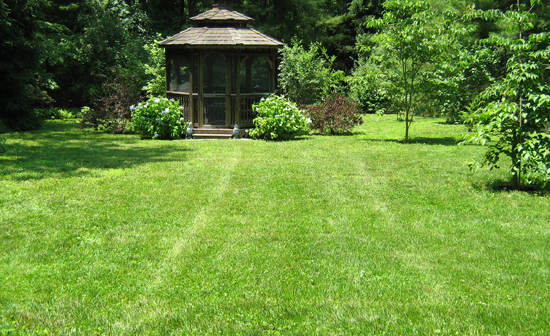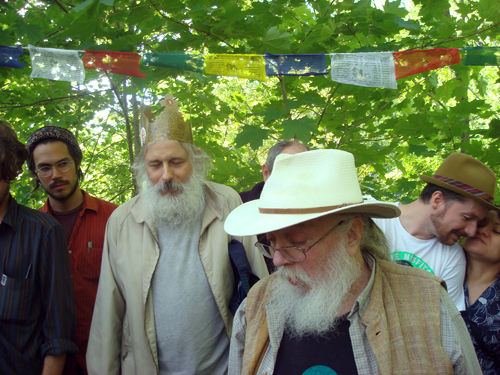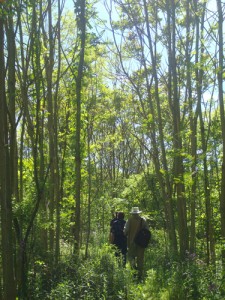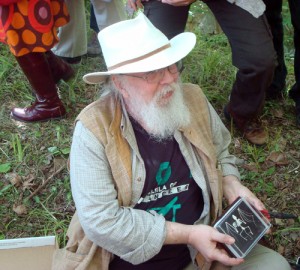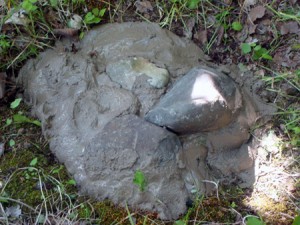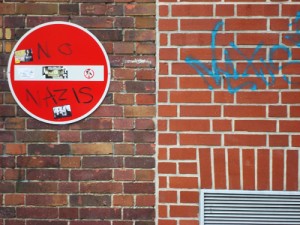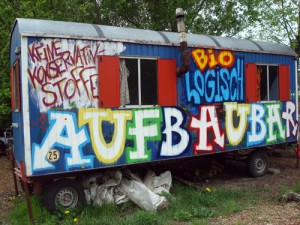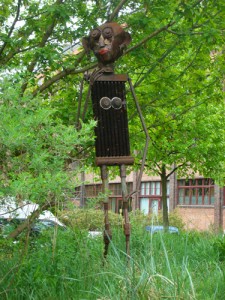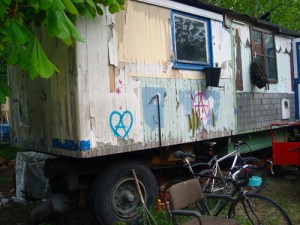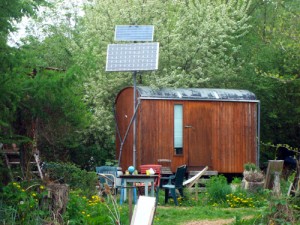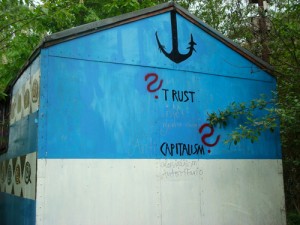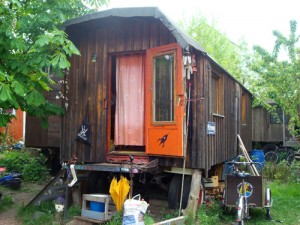Environment
 Beautiful Fungus!
Beautiful Fungus!
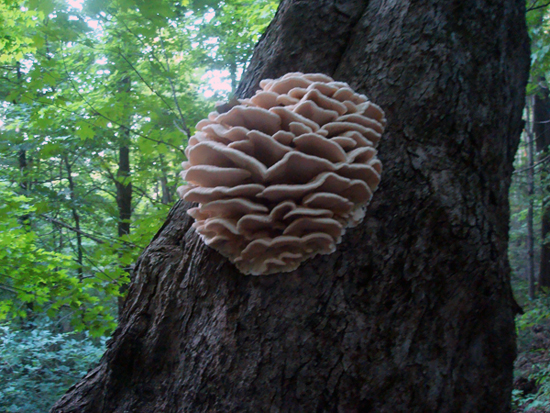
During one of my recent walks in the woods at Mohonk, my friends and I came upon this beautiful fungus!
It appears to be a shelf fungus known as Laetiporus sulphureus – also known as “Chicken of the Woods” – though this young specimen is not as yellow as that species is known to be. It is likely at least a close relative, though, or just a purely whiter young bloom that has yet to yellow with maturity. Recent DNA studies have split up what used to be universally recognized as L. sulphureus into six different species in North America alone, but L. sulphureus is the one that tends to take up residence in the Northeast.
Chicken of the Woods – like the title suggests – is edible. No hallucinations or anything, but you know, if you’re ever in a bind for food…
I feel bad for the tree, though. This fungus is not just saprobic (feeds on dead trees) but also parasitic (feeds on live ones). It is a heart rot fungus and is seen high up on the tree, as you can see in the photo. Of course, by the time you can see it in full-Chicken bloom, it’s already too late.
The heart has rotted.
The tree will die.
Such is the seeming relationship between beauty and death.
And so, the forest becomes its own stage for tragedy, unfolding its quiet story before the wanderers attuned to its mysteries.
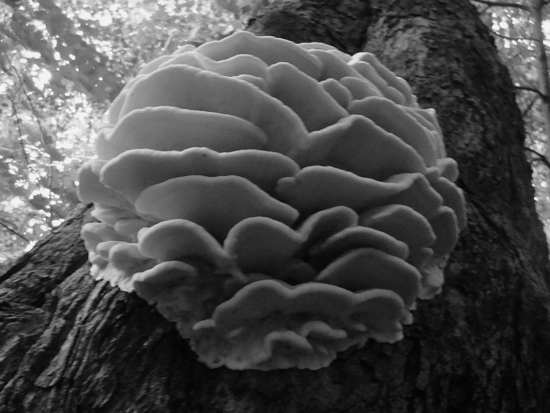
 Where the Grass is GREENer
Where the Grass is GREENer
by Connie Adamo (guest blogger and Ayesha’s Mom)
I have a little place not too far from the Jersey Shore and have gardened for a number of years. I love the extraordinary variety and abundance of life in my yard. Over the years, using sustainable practices, I have been able to create a little haven.
Today I will talk about having a green lawn without poisoning the environment and killing wildlife – a place where children can play without becoming contaminated by truly frightening pesticides, herbicides and fertilizers – a lawn that can be maintained with very little, if any, watering.
First, it is important to know your growing conditions, i.e. your area of the country, local soil conditions (in your yard) and the amount of light the area receives. I find that careful observation is a great help here. You may also contact your county soil conservation office and many universities have a cooperative extension service that can help with soil testing if you need it. Once you have an idea of what your conditions are and make soil amendments if needed, you should seed with grasses that will thrive in those conditions. In my area, which is Zone 7 and the Northeast, the following grasses are usually successful: fine fescues, red chewing fescues and hard fescues with a small dose, maybe 15%, of perennial rye grass. There are many seed mixtures that contain these grasses. I also include white clover and a happy collection of volunteer greens and assorted acceptables, which can be any low growing ground cover that doesn’t look awful and blends.
My yard is large with varied conditions. I use fescues and white clover near the house, and towards the back, which is quite sunny, I use the grasses and clover mixed with buttercup, wild strawberry, violets, and gill-over-the-ground. I even include a few dandelion and plantain. Having this variety of grasses and plants helps to prevent disease and pests that monoculture invites.
Fertilizing my lawn is usually done twice a year, spring and fall, although it can be less, as it is important not to overfeed. Organic fertilizers are available at many garden centers and in catalogs. Some choices may be dehydrated cow manure, compost and corn gluten meal. Corn gluten meal can be used as a pre-emergent herbicide for crabgrass and broadleaf weeds you may not want. If using corn gluten meal, apply four to six weeks after sowing seeds. I usually overseed with grass and clover in spring and/or fall. I just throw it around where the lawn seems to need it.
With regards to mowing, mow between 3 and 4 inches high and leave the clippings on the ground to fertilize the grass. Mowing high will protect the grass and cut down on watering. Watering should not be necessary unless there are extraordinary conditions. The lawn may go dormant but it will be just fine.
There are also many other earth friendly ways to landscape your space and create a backyard that is busy with life and beauty, but that would be another topic.
 Entering the Temporary Art Zone with Hakim Bey
Entering the Temporary Art Zone with Hakim Bey
“The art, such as it is, comes into existence only in the moment of its own disappearance; afterwards it will be invisible—except to the spirits” – Peter Lamborn Wilson
• • •
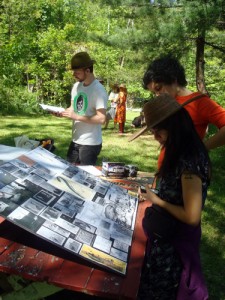 On May 15th 2010, Peter Lamborn Wilson, known to many as Hakim Bey, completed another happening in a series of events aimed at re-enchanting the landscape of forgotten or not-yet-revealed sacred places in upstate New York. These acts of “Endarkenment,” a term Peter uses to mean “fear & respect as well as love for Nature,” are the culmination of his last ten years of research in Ulster County and the surrounding areas. He’s putting the magick he dug up back into the land.
On May 15th 2010, Peter Lamborn Wilson, known to many as Hakim Bey, completed another happening in a series of events aimed at re-enchanting the landscape of forgotten or not-yet-revealed sacred places in upstate New York. These acts of “Endarkenment,” a term Peter uses to mean “fear & respect as well as love for Nature,” are the culmination of his last ten years of research in Ulster County and the surrounding areas. He’s putting the magick he dug up back into the land.
Peter has called this a “temporary landscape installation piece.” It is art that disappears and defies a fetishized place on the 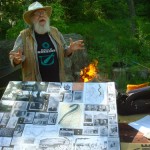 gallery wall. While it bears a resemblance to landscape art, it is more than that, for its goal is to enact the magick of enchantment on the land where each work is performed. The documentation of each of these works includes a hand-written essay, and this May 15th working also featured a large storyboard with pictures and photographs significant to the occasion.
gallery wall. While it bears a resemblance to landscape art, it is more than that, for its goal is to enact the magick of enchantment on the land where each work is performed. The documentation of each of these works includes a hand-written essay, and this May 15th working also featured a large storyboard with pictures and photographs significant to the occasion.
After Peter’s short talk about his research leading up to this event, a few helpers went ahead to make preparations, followed by Peter and his large box labeled “Jukes.” Slowly, the rest of us followed in single file along the narrow towpath where mules used to tread, hauling boats, when the Delaware and Hudson Canal was operational.
In my understanding of it, there were three main groups called forth for reawakening in this work:
one group that has already disappeared, one that is disappearing, and one that now returns.
The group that has already disappeared is known as the Jukes, or at least that’s the name that flawed social scientists gave to this now infamous community of families when they were the target of eugenics studies in the 1800’s. The flaws in these studies have since been recognized, but what still remains fascinating about the Jukes is the reason that they were targeted for such studies to begin with: they were what Peter calls, “a drop-out society,” not unlike the modern day Ramapough Mountain Indians from New Jersey, who were the subject of the recent New Yorker article “Strangers on the Mountain.” But the Ramapough Mountain Indians, 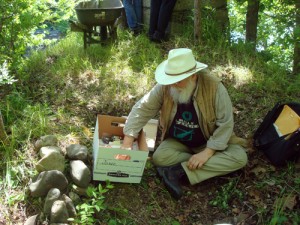 or “Jackson Whites,” as they have been called, have kept their society, even with the skyscrapers of New York threatening on the horizon. They have also kept their mountain – even with the enduring effects of the toxic waste that the old Ford factory dumped on it decades before. The Jukes have not been so lucky – if you can call it luck. While descendants of the Jukes surely still exist, their isolated drop-out community has vanished, and they seem a distant legend in the Ulster County of 2010. All that remains of the Jukes today can be found in a poorhouse graveyard in New Paltz that was re-discovered in 2001, and in the records kept by the poorhouse and those in the archives of the SUNY Albany library. The once vibrant living community of Jukes has now vanished.
or “Jackson Whites,” as they have been called, have kept their society, even with the skyscrapers of New York threatening on the horizon. They have also kept their mountain – even with the enduring effects of the toxic waste that the old Ford factory dumped on it decades before. The Jukes have not been so lucky – if you can call it luck. While descendants of the Jukes surely still exist, their isolated drop-out community has vanished, and they seem a distant legend in the Ulster County of 2010. All that remains of the Jukes today can be found in a poorhouse graveyard in New Paltz that was re-discovered in 2001, and in the records kept by the poorhouse and those in the archives of the SUNY Albany library. The once vibrant living community of Jukes has now vanished.
The second group, the group that is in the process of vanishing, is the bat community. All along the East Coast and into the Midwest, bats have been found dead in the hundreds of thousands. 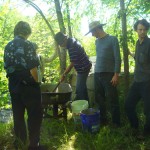 The bats are dying of “white-nose syndrome,” so named for the white fungus, Geomyces destructans, that can be seen on the muzzles of infected bats. It is still uncertain whether the fungus is the disease or whether it is able to take hold of an immune system already weakened by some other disease, though it seems that the fungus itself is the culprit. Bats are a major predator to insects, not just the insects that interfere with us on a hot summer day, but also those that interfere with the growth of crops. The threat of imbalance in the ecosystem, as well as the possibility of extinction for many species of bats, is a serious concern for us all as we watch this community of animals suddenly disappear.
The bats are dying of “white-nose syndrome,” so named for the white fungus, Geomyces destructans, that can be seen on the muzzles of infected bats. It is still uncertain whether the fungus is the disease or whether it is able to take hold of an immune system already weakened by some other disease, though it seems that the fungus itself is the culprit. Bats are a major predator to insects, not just the insects that interfere with us on a hot summer day, but also those that interfere with the growth of crops. The threat of imbalance in the ecosystem, as well as the possibility of extinction for many species of bats, is a serious concern for us all as we watch this community of animals suddenly disappear. 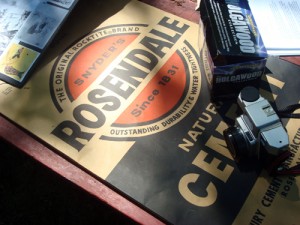
The last group, the one that returns, is the cement itself, which was to be the bonding agent of all that went into this day’s working of Endarkenment. Standing on the aqueduct bridge abutment designed by Roebling in 1850 and overlooking the Rondout Creek, it seemed only fitting that the cement used for this occasion should be Rosendale Natural Cement, which was the business that founded the nearby town of Rosendale during the construction of the Delaware and Hudson Canal. The cement was first discovered in Rosendale during the excavation of the canal bed for the D & H Canal in 1825, and would later be used as one of the materials in the building of the canal itself. Rosendale Natural Cement was also used in the construction of Roebling’s aqueduct bridge, the remaining abutment on which we then stood, and in his later and more famous project, the Brooklyn Bridge. Despite the popularity of Rosendale Cement in the nineteenth century, the introduction of faster-setting Portland Cement meant the end of natural cement production in the twentieth century. By 1970, the last of the cement mines in Rosendale were closed. Natural cement was no longer available.
But in 2004, natural cement made a surprising return when Edison Coatings, Inc decided to resurrect production of Rosendale Natural Cement. The main reason behind this comeback was the need to restore buildings and monuments that were originally constructed using natural cement, 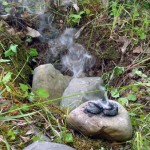 though it turns out that Rosendale Natural Cement is actually “greener” than modern Portland Cement. Due to its much lower firing temperatures and the ease of grinding, natural cement requires less energy to produce.
though it turns out that Rosendale Natural Cement is actually “greener” than modern Portland Cement. Due to its much lower firing temperatures and the ease of grinding, natural cement requires less energy to produce.
As we gathered around Peter to watch this artwork in its vanishing, an artwork that is being done for those who vanish, the scent of copal mixed with other incenses – those he had burning on the rock before us, and those of the forest itself.
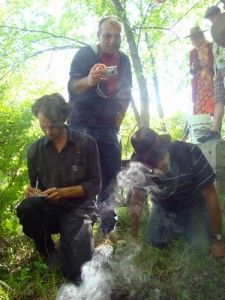 The artwork happened simply. There was little ceremony, perhaps to the confusion of some in attendance who had hoped for a chant or a reading. Peter presented items, one by one, and placed them into a hole in the ground that would be filled with cement. Among these were crystals, a fancy bat skeleton from Carolina Biological, the remains of the incense itself…it made me wonder: must things be buried that they may return? Do we re-enchant our environment when we return to the point zero?
The artwork happened simply. There was little ceremony, perhaps to the confusion of some in attendance who had hoped for a chant or a reading. Peter presented items, one by one, and placed them into a hole in the ground that would be filled with cement. Among these were crystals, a fancy bat skeleton from Carolina Biological, the remains of the incense itself…it made me wonder: must things be buried that they may return? Do we re-enchant our environment when we return to the point zero?
For Peter’s magickal purposes in this act of art, I believe it was significant that the natural cement local to this area, the one element in the work that had gone from a state of disappearance into new life, should be the bonding agent for all the others. As the creation of this temporary installation piece was executed, we watched closely as items disappeared into the hole, as their physical passage from the box labeled “Jukes” into the hole before us disappeared into memory. All of this was then sealed by cement and rocks found around the site the day before. While the process of art may have vanished, the evidence of the act endures. Like the Brooklyn Bridge, the pedestal of the Statue of Liberty, and Grand Central Terminal, this momentary work was made using Rosendale Natural Cement. Its purpose is beyond that of a monument, but the place of Endarkenment was built to last just the same, even if it was now only visible to the spirits, as Peter says.
After we traveled back along the narrow towpath and out of the woods, a little boy who was playing pointed up to the sky, and we all saw it: a small rainbow showing itself faintly through the trees, though it hadn’t rained at all. The enchantment was complete, and the signs of this were not only visible to the spirits, but also to us.
*** Peter’s statements that have been quoted here are from the press release of a previous related event. You can read his writing on that event here:
http://www.sevenpillarshouse.org/article/first_vanishing_art/
7VPZM2AUKGJM
